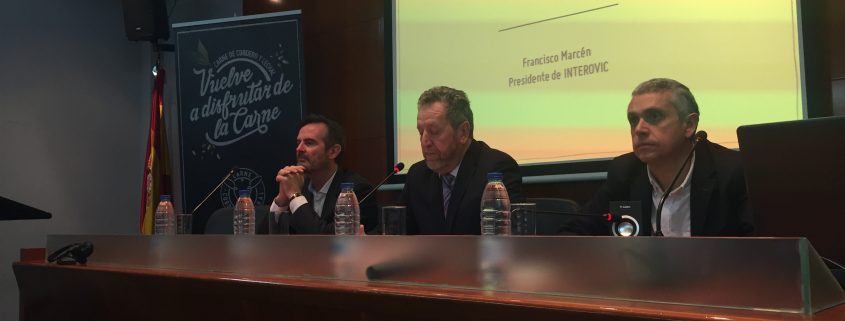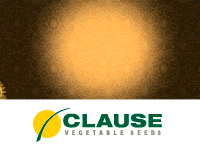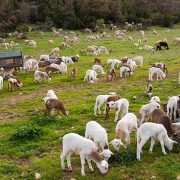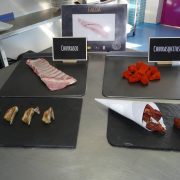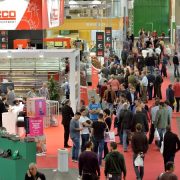Consumption of lamb discussed in Seminar II INTEROVIC
More than 100 attendees at the conference, in which the progress and next steps were discussed to secure the reversal of lamb consumption in Spain INTEROVIC request in Brussels in 2018, the lamb is a priority product in their promotion policies because of declining production and consumption in the EU.
The conference organized by INTEROVIC in Madrid where he met the whole sector of Spanish sheep and goats from production, processing, marketing and distribution, together with specialists from Magrama and other specialized companies, was a success.
The aim of the conference was to bring together all subsectors grouped around the Interprofessional, along with representatives of Magrama and marketers to put on the table what the current situation after one year of implementation of the first European program to promote the consumption of meat codero in Spain through the campaign “lamb and suckling: Relive the flesh.”
The inauguration was led by the president of INTEROVIC, Francisco Marcén, who presented the day and thanked the assistance to representatives of the entire value chain, responsible for Magrama, Market Consultant Ikerfel, AGR Food Marketing & Media .
The next speaker was the president of AGR Food Marketing, Mateo Blay, who said that from the beginning the main objective of the campaign was “positioning lamb meat as a natural, easy to cook and for day to day.”
He highlighted the good performance of European “because when things are done well, go well”, adding that changing consumer habits and especially the lamb-and that is a flavor or like- like it or not is a task medium and long term.
In this regard, he said to achieve this it is essential “to value the new cuts and presentations of beef and lamb which such acceptance are having among key prescribers of product, accompanied by the traditional consumption, consumption that is part of the festivities and weekends and as a group. ”
INTEROVIC coordinator, Tomas Rodriguez, took stock of all the actions carried out during the first year of promotion campaign by ensuring that 77% of households surveyed in a poll conducted by the consulting Ikerfel claims to have eaten lamb for last year, a third of the butchers are already introducing new cuts and presentations, 7% welcomes the campaign slogan and has achieved a spontaneous awareness campaign 46% in the consumer.
He also said that most of the first year of work have been visits to butcher (5,500) and training sessions for future chefs and butchers in Spain (50), “which has allowed us to reach 18,000 butchers, almost half of which are in Spain. ” He also noted that a cornerstone of the campaign is still the web, “tool again comes to young people (target audience), and the excellent results in RRSS leading the ranking in the segment of activity.”
Txema Irasuegi, Consultant Ikerfel stressed that the campaign in the first year has reached nearly 50% of housewives therefore the actions and for the TV spot and slogan chosen. At this point, he said that “actions such as butchers cornerstone of the bell have been really satisfactory.
Responsible for the account in AGR INTEROVIC Food Marketing, Irene Simon, advanced actions to be performed during the second year of the campaign, explaining that it will continue to consolidate the work of information and training of modernization of the product between butchers and responsible for mass distribution. Additionally, he said that he will put the focus on giving “greater visibility to the product and its different uses, establishing cooperation agreements with gastronomic prescribers or presence on television.”
The head of the French Inteprofesional, INTERBEV, Marianne Orlianges, presented the campaign “Year presto”, being developed in six markets (France, UK, Germany, Ireland and Belgium) and puts the focus on two topics: the European lamb meat is modern, beneficial, and it is a very qualitative product produced in a sustainable manner.
A campaign that has many points in common with the Spanish such as the emphasis on new forms of processing (issue that had to insist to be from 6 different countries) and is also based on the new courts.
Esperanza Orellana responsible for promotion programs Magrama explained the new European regulations and said it is key to internationalization tool. The export of sheep, said, “It is seasonal so it is rather a mechanism for regulating the market and not a sectoral strategy.”
During the day in the afternoon, Maria Cristina Gomez, also from Magrama and market expert analyzed the global situation of sheepmeat and explained the FAO data relating to 2013 highlighting China as the largest consumer country with the highest census sheep, (production of 4 million tons).
In conclusion, he explained that the global outlook for demand for sheepmeat continue to rise; China’s production will continue without satisfying local demand, land, labor and environmental issues will be the main limiting, but productivity will continue to increase and meat prices will remain at good levels.
Josefa Lueso (Magrama) Vicente Carrion (Production), Fernando Cervera (Industry), Felipe Medina (Distribution) and José Moya (representing the retail sector): Finally, a panel discussion moderated by Francisco Marcén with the participation was held.
It matters of interest to the field of sheep and goats presented to the European Commission in upcoming meetings were raised.
Source: INTEROVIC




